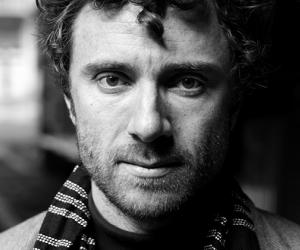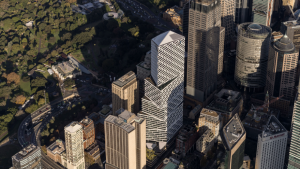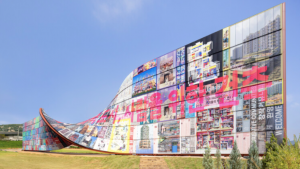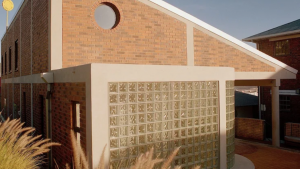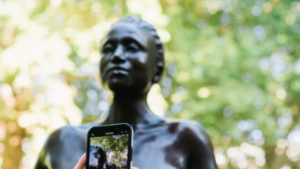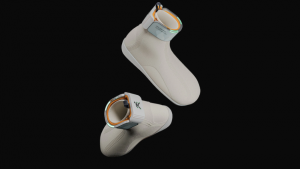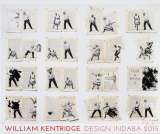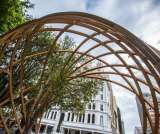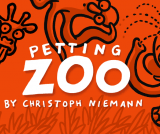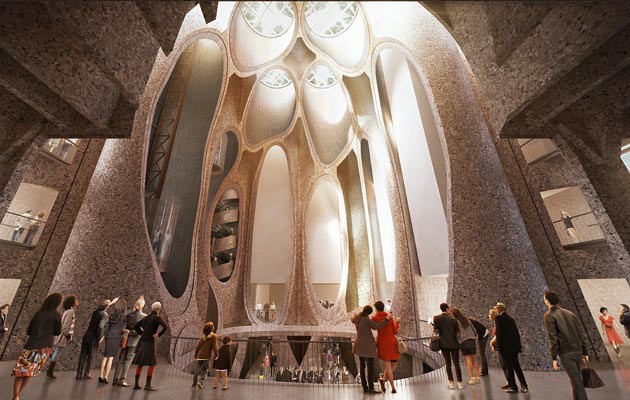
Thomas Heatherwick has unveiled plans to convert a giant concrete grain silo on the Cape Town waterfront into the continent’s first museum devoted to contemporary African art. It is already proving to be one of the British designer’s most heartfelt projects
In an auditorium in Cape Town, Thomas Heatherwick is giving an animated talk about his London studio, which is 20 years old this summer. Often described as resembling a final Marx brother, the 44-year-old Heatherwick has two-week stubble and a curly mop of black hair. He is dressed in a thick waistcoat, clunky shoes and baggy trousers decorated with broad dotted lines.
As he takes the audience on a modest tour of his prolific output – the Seed Cathedral for the Shanghai World Expo, the double-decker London bus, the kinetic Olympic cauldron, the proposed garden bridge over the Thames – he frequently resorts to histrionics to make a point: he recoils in mock disgust at the neon safety poles used in previous buses; he sticks out his belly to imitate the undulations of the specially cast concrete columns in the campus building he is completing in Singapore. He talks sincerely about giving concrete “more love”, and jokes of the “inner pervert in all of us” that can’t resist reaching out to touch such pregnant forms.
Then Heatherwick pauses to make what he calls “an exciting announcement”, and the mood changes. He seems to well up with emotion – his hands are trembling, people lean forward as if to inspect whether there are actual tears. “He was super emotional,” Ravi Naidoo, the organiser of the Design Indaba conference, tells me later. “He was absolutely vibrating, and in fact he said to me afterwards that he’s never felt so emotional about launching a project before.”
Heatherwick unveiled his plans for converting a massive grain silo on the Cape Town waterfront into the Zeitz Museum of Contemporary Art Africa. Once the tallest building in South Africa (at 57m), the silo closed in 2001 and fell into dereliction, a hulk of concrete that was an awkward eyesore in a gentrifying district. His renovation will make it, he says to wide applause, the first museum of contemporary African art anywhere on the continent (and it will be his first building in Africa). The talk ended with a standing ovation.
“I loved how odd it was and how it had such confidence,” Heatherwick says, remembering his initial impressions of the silo. He first saw it in 2005, on an earlier speaking trip to Design Indaba, when Naidoo introduced him to the building’s new owner, who invited him to help turn it into a hotel. At that stage his only completed building was a beach cafe, made of contours of rusty steel, and he was best known for shop interiors and an ingenious furling footbridge.
“I spent two days walking around it and crawling through pigeon guano – worse than anything I’ve ever smelt – and imagining what that project might be,” Heatherwick says. “My mind was already playing with the dynamic of a building made of tubes: how do you take advantage of that tube-iness rather than fight it?” Built in the early 1920s, and fitted with machinery made in Manchester (where Heatherwick went to college), the silo had just stopped being used. “In Europe we’re used to having infrastructure that’s been out of use for decades and decades. So there was a sort of modernity to it – even though we’re working with heritage it seems somehow recent.”
The silo was bought by Dubai World, and Heatherwick’s hotel didn’t happen, but several years later, after the emirate crashed, it changed hands again. The new owner, Growth Point, one of South Africa’s biggest property management companies, commissioned others to come up with proposals as to how to convert it. “Every architect of any consequence in this country had a stab at doing something,” says Naidoo. “And some of these proposals were absolutely hideous, completely cringe-worthy. One crazy scheme had portholes in the silo tubes and a sign above saying Holiday Inn Express – they were going to convert it into a hideous, frigging three-star hotel!”
Naidoo suggested a cultural venue be created instead, and once again put Heatherwick’s name forward. The developer, convinced that a museum would add value to their surrounding holdings, was won over. Naidoo then traipsed around the world with Heatherwick’s model in a hatbox looking for a suitable patron. Jochen Zeitz, the Puma chief executive who was then searching for a home for his large collection of African art, jumped at the opportunity.
When I visit the Victoria & Alfred Waterfront, the silo, with its 42 concrete tubes, which once stored 30,000 tonnes of grain, is shielded by hoardings, an island in an area of busy development. Grain elevators were once temples to modernists: Walter Gropius wrote that they were “almost as impressive in their monumental power as the buildings of ancient Egypt”, while Le Corbusier called them “the magnificent first-fruits of the new age”.
The silo, in all its faded industrial grandeur, was a piece of a much larger infrastructure and it is surrounded by other remnants of a busy port. Train sheds, where grain from the countryside was first received, have fallen into disrepair. In nearby dry docks stand the rusting hulls of ships. But it is apparent that the area is on the verge of change, being swiftly cannibalised for offices and warehouse flats. The precinct on the other side of the harbour is now one of the most visited by tourists in Africa, and this area promises to be as successful
The silo is painted magnolia, which Heatherwick describes as the kind of colour you would decorate “Granny’s bedroom” and he believes this “confuses the crispness of the powerful, vertical geometry”. But a rupture to one of the cylinders revealed a concrete peppered with beautiful blue stone, which Heatherwick plans to strip the building back to. Inside the elevator tower, where the grain would have been scooped up and deposited in the silo tubes, construction workers are dismantling the rusty machinery, which clatters through the building as it falls.
Heatherwick describes the “very efficient, if slightly perilous system” once used for getting workers around the tower. They would grab onto a rubber belt, with wooden blocks on it for their feet, which whipped them quicklyup through the building. To come down, there were fireman’s poles that were offset through each floor, “so you could quickly descend through the equivalent of a 14-storey building, probably quicker than any lift.”
A hole has been smashed into the side of one of the concrete tubes clustered behind the elevator building, and we shuffle around a portaloo to climb into the dark interior. The floor is bowled (the stored grain would be funneled onto a conveyer belt below when needed) and as you look up its great, echoing height you can see daylight through the tiny aperture down which the grain once dropped. Heatherwick proposes to carve through these tubes to create a volume that will link them to the tower.
“We were aware that we needed to make some space where you could get a clear head when you arrived, to help people understand how to move around. To me, the more you need signage, the more you’re failing as a designer. We had a sense we needed to carve out an opening, and stitch together what is essentially two buildings.”
Avoiding the perfect sphere or ellipse, considered too clinical, Heatherwick decided to cut through the tubes in an imperfect grain-shaped form, which will reveal the cruciform patterns in the spaces where the cylinders join (one can see a continuity here with his Seed Cathedral). “We wanted the void to have some life to it,” he explains, “to allow your brain to try and make sense of its irregularity meeting the utter, ruthless regularity of the tubes.”
Some of these opened tubes will house glass pod elevators and spiral staircases, which Heatherwick likens to the piles that might have originally drilled these holes through the building. “We all made things at school out of cardboard tubes, and in a sense there is this great familiarity,” he says, “but the funny thing with all these spaces is that they’re the wrong shape to show art in.” Having given the clue
as to its former use in this central atrium, he decided to hollow out the bulk of the building to create the required gallery spaces. The exterior of the silo will remain largely unchanged. “There’s been this strong sense of the outside of buildings being this fandango,” Heatherwick says, “and particularly in Asia, where we’ve been doing a number of projects, there’s been this great urge to do things where the outside does a big communication job to explain how cultured an individual,
or a company, or a city is.
But this building had a strong character already and it felt embarrassing to take that on in some way, to compete with that.” He will enlarge the windows in the elevator shaft, stripping them back to their concrete-covered steel frames, and proposes to fill them with bulging glass that looks like it’s been blown through these openings. Heatherwick talks about the “world of flat, sterile glass, and its clinical reflections”. Inspired by the Venetian lampshades that were traditionally blown through chicken wire moulds, he will use facets of regular glass to create pillowing shapes that will distort the dramatic view of Table Mountain and the sea.
While Heatherwick maintains the integrity of the listed building, this glasswork, which in renders seems to ooze out of the building like an explosion in a bread factory, introduces to the scheme Heatherwick’s now trademark eccentricity. The budget of the building is small – £30 million – and Heatherwick talks of focusing his interventions on a few parts of the silo to “add maximum value”.
For all the desire to avoid a “fandango”, his clients look to him for such show-stopping moments of cleverness. Early on his studio became well known for its laborious Christmas cards, each of which was a miniature sculpture that riffed on some concept of postage. (One featured a series of green-lined envelopes nested inside each other like Russian dolls, which opened to form a Christmas tree.)
Heatherwick is brilliant at creating such ingenious baubles, and is sometimes criticised for only making crafty one-liners. But what’s wrong with baubles? A month later I meet him again at his busy King’s Cross studio. It doubles as a museum of the studio’s work, much of which was on show last year at the V&A. There are models of architectural schemes, realised and not, prototypes of his furniture pieces, as well as various curios that have inspired him; for example, a toy that pumps Play-Doh through holes in plastic heads to create brightly coloured hair, which apparently influenced the spiky extrusions of the Seed Cathedral.
At Design Indaba, Heatherwick had spoken about the “quiet cynical optimism” that resulted from Olympic success and which he believed made the copper-nickel-clad bridge he is planning between Temple and the South Bank in London a possibility (an idea proposed by Joanna Lumley). Lumley wanted a green crossing that would provide ample “spaces for a tryst”.
In Heatherwick’s design the leaf-like edges of the bridge provide a series of nooks for such encounters and the greenery seems to express the architecture, with the tallest trees situated over the legs of the bridge. Has he ever, in doing so many high-profile projects that have served to rebrand Britain, felt victim of such cynicism?
“The British have a wonderful and terrible cynicism,” he answers. “This scepticism is a great quality because it can burst bubbles and debunk bullshit, but I didn’t ever want to be hardened or cynical myself – I’ve always believed that you must just work out for yourself what’s the best thing to do and believe the best of your fellow man. Don’t cut back your ambition. I’ve forfeited doing other kinds of projects to do public work – we’re not doing anyone’s private home, any golf clubs in Nanjing. All our projects are public, that’s what excites us, but they’re the hardest, because everyone’s got an opinion. It’s learning how to navigate that without becoming cynical.”
When asked if he might use his new influence in the political arena, as Richard Rogers has done, Heatherwick claims not to be a party animal. “I don’t have a mantra that if everyone did what I say the world will be a better place, so I’m very wary of that.” “We’re all interested in ideas,” he continues. “We’re all here together trying to make things better, or make a difference. And that sounds dumb, the most inane thing to say, but in those rare moments when you get the feeling that it was worth it, that fulfils you and sustains you, and when a project feels like it has managed to make a difference, it tends to give people more encouragement that things are possible. I think in the 1970s and 80s in Britain, in a time when conservatism was really engrained, we were all brought up to think things weren’t possible.”
When he first visited South Africa in 2005, Heatherwick says, he was inspired by its energy, keen not to just have a holiday and go home but to “give something back”. I ask him why he was so obviously moved to show the silo project. “You were there the first time I’d ever had the chance to explain it,” he says. “And its astonishing that the entire continent has no museum for contemporary African art. I was being given the chance to tell everyone there will be, and whether our design’s rubbish or not, that’s an incredibly exciting thing.”

